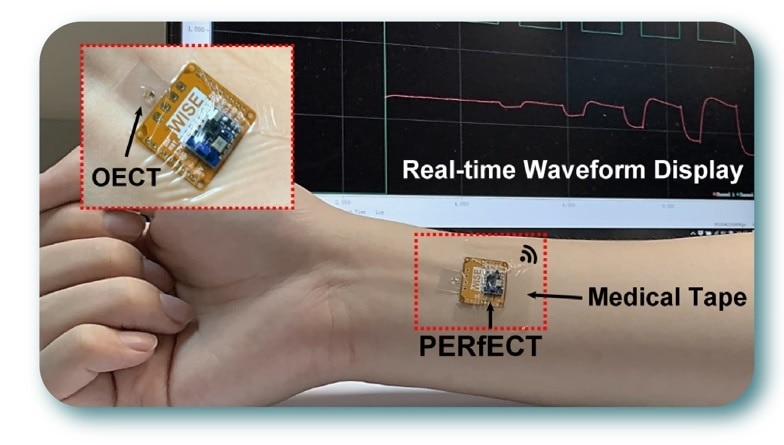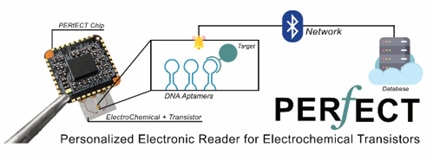
MIT's new wearable sensor design detects and transmits vital biomarkers without an integrated chip. (Image Credit: MIT)
Stick-on wearable tech is in the news again this week. If only they could all team up?
Today's wearable sensors rely on battery-powered Bluetooth chips to transmit data. However, these chips and small batteries could be too bulky for next-gen sensors, which have smaller, more flexible, and thinner forms. MIT engineers developed a wearable sensor capable of wireless communication without relying on a chip or battery. This new design, which consists of electronic skin and an ultrathin, high-quality gallium nitride film in the center, paves the way toward achieving chip-free sensors.
The engineers applied a remote epitaxy technique, which peels away the gallium nitride's single-crystalline films that serve as an extremely sensitive piezoelectric material in its defect-free form. They discovered a method to harness gallium nitride's two-way piezoelectric properties to detect and wirelessly transmit surface acoustic waves. The acoustic waves refer to vibrations across the film in this case. As a result, the device exhibited high sensitivity, causing it to vibrate upon detecting a human's heartbeat and compounds on the skin, including salt in sweat.
These vibrations also produced an electrical signal read by a wireless receiver nearby. This allowed the device to transmit data wirelessly without an onboard chip. According to the team, a gallium nitride-based sensor worn on the skin could have a resonant vibration that the piezoelectric material converts into a signal. A receiver then reads the signal's frequency. Changes in skin conditions would affect the sensor's mechanical vibrations and the transmitted electrical signal.
"If there is any change in the pulse, or chemicals in sweat, or even ultraviolet exposure to skin, all of this activity can change the pattern of surface acoustic waves on the gallium nitride film," notes Yeongin Kim. "And the sensitivity of our film is so high that it can detect these changes."
They also created pure, single crystalline gallium nitride film samples, pairing them with a gold conductive layer to enhance all incoming or outgoing electrical signals. The gold's repeating dumbbell pattern provides flexibility to the rigid metal. The gallium nitride and gold serve as electronic skin, measuring just 250 nanometers thick.
Afterward, volunteers wore the e-skin on their wrists and necks, and an antenna wirelessly registered the device's frequency. The device then detected and transmitted the gallium nitride's surface acoustic waves' variations based on the wearer's heart rate. In addition, the engineers paired the device with an ion-sensing membrane, which pulls in a target ion and sodium. This configuration allowed the device to detect sodium level changes while the participant sweats from holding a heating pad.
Overall, the team believes their work will eventually lead to chip-free wireless sensors. The device can also pair with other membranes for essential biomarker monitoring. "We showed sodium sensing, but if you change the sensing membrane, you could detect any target biomarker, such as glucose or cortisol related to stress levels," says co-author and MIT postdoc Jun Min Suh. "It's quite a versatile platform."

HKU's PERfECT wearable system monitors and measures mental health, diabetes, and cardiovascular diseases. (Image Credit: Analytical Chemistry)
University of Hong Kong (HKU) researchers created PERfECT (Personalized Electronic Reader for Electrochemical Transistors), a coin-sized wearable system that detects weak electromagnetic signals. This device has practical applications for monitoring and measuring mental health, diabetes, and cardiovascular diseases.
PERfECT measures just 1.5 cm x 1.5 cm x 0.2 cm, making it the world's smallest type and weighs 0.4 grams. The wearable system can also integrate with a smartwatch to monitor biosignals like glucose levels and blood and sweat antibody concentrations.
"Our wearable system is tiny, soft and imperceptible to wearers, and it can do continuous monitoring of our body condition. These features mean it has the potential to revolutionize healthcare technology," said Dr. Shiming Zhang who leads the HKU WISE (wearable, intelligent and soft electronics) Research Group to develop the system.

(Image Credit: Analytical Chemistry)
The wearable device marks a major milestone for organic electrochemical transistors, the next-gen sensing technology that offers water stability and high sensitivity at a low operating voltage (milli-volts). PERfECT also precisely characterizes an electrochemical transistor's performance, achieving up to 200-kilo samples per second, a data sampling rate equivalent to bulky commercial equipment.
It can function as a small electrochemical station for wearables, measuring outputs of varying low-voltage transistors, including electrolyte-gated field effect transistors and high-k dielectric-gated thin-film transistors. The team formed SESIC, a startup aiming to make the technology accessible.
"We have been able to develop the PERfECT system because of the unique, interdisciplinary culture in the HKU WISE Research Group, which includes researchers from electrical engineering, applied chemistry, biomedical engineering, microelectronics and software engineering. I have also made it a point to recruit young, promising undergraduate and postgraduate students to our team," said Dr. Zhang.
Have a story tip? Message me at: http://twitter.com/Cabe_Atwell
